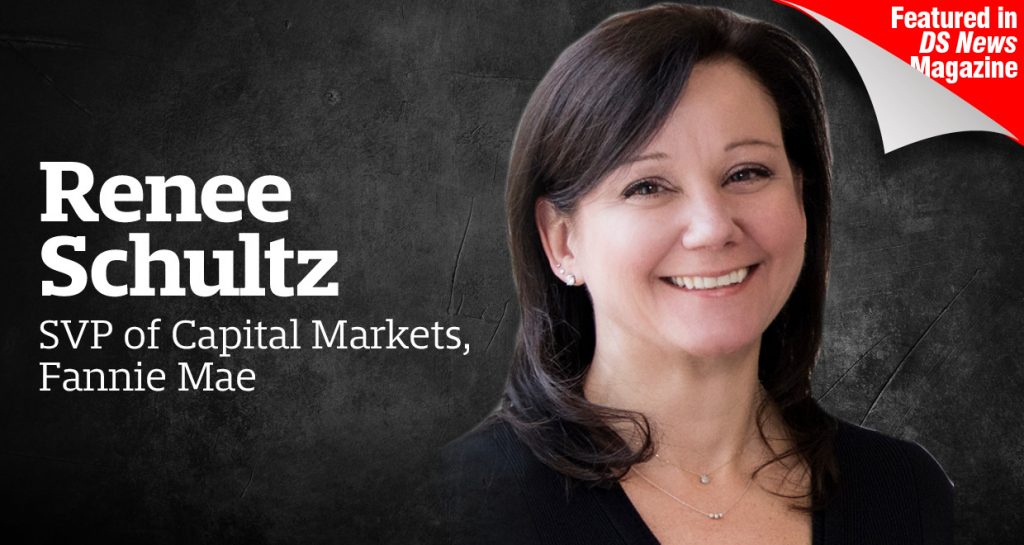
Editor’s note: This feature originally appeared in the January issue of DS News.
As SVP of Capital Markets, Renee Schultz manages Fannie Mae’s Capital Markets Pricing and Sales Desk, MBS trading, the Credit Risk Transfer programs, Structured Transactions, and the Whole Loan Conduit. She also oversees the Securitization policy team, which ensures proper administration of matters related to the strategy and business value of Fannie Mae securities.
Schultz recently spoke with DS News about last summer’s rollout of the Uniform Mortgage-Backed Security, Fannie Mae’s ongoing commitment to innovation, and new developments in credit risk transference.
One of the biggest stories on the GSE front was the rollout of the UMBS last summer. What takeaways came out of that process?
The Single Security Initiative, which has been going on for almost six years, was market transforming. We started trading forward securities in March and the official launch of the Uniform Mortgage-Backed Security was in June. It was a very smooth and orderly transition.
Most of the people involved with the initiative spent six years of their life on it and saw it through all the way to completion. We were all in agreement that the worst possible outcome would be to disrupt the TBA (tobe-announced) market. If you think back to the financial crisis, the TBA market was the only market really functioning. So, to do any kind of harm to that market would have been disastrous. We needed to be confident that when we did go live it was functioning smoothly and we were not going to have any bumps in the night.
We have ongoing monitoring of the securities to make sure that they are aligned so we don’t have any kind of bifurcation in the market.
With that years-long project now launched, where do you turn your focus now?
We have a lot of different capital market initiatives, many of them focused on the customer—not just in the traditional sense of seller-servicers, but also investors. We’re trying to build out some capabilities for the entire customer base.
There are some tools that we continue to build out and refine such as our Servicing Marketplace for seller-servicers. We also have a tool called Investor Direct that we’ve been building for investors that enables them to structure transactions. Investors don’t have to pick up the phone anymore. They have the ability to upload their collateral, and we’re continuing to build on that technology. We’ve heard resounding positive comments from the investor community, saying that we’ve made it so simple for them.
That’s a real focus for us: we want to make things simple for the industry, and we want to bring certainty and efficiency.
Is the way you interact with and get feedback from your customers changing?
We work closely with a team that we call CXD, and they help us identify small groups of customers that we want to seek out for feedback. Once we have a concept we want to explore, we can run it past one of these groups—sort of a focus group—to ask, “Is this something that is of value to you?” We usually have a good sense of whether the need is there, but sometimes we’ll hear back from customers that there is a more pressing need elsewhere that needs attention.
This process of seeking feedback from customers really helps, because everything we do is in an Agile build. It helps us compartmentalize. What are our objectives? What is most important? The nice thing about being agile is you can go back and tweak a concept fairly easily without the need for a long timeframe and testing and progression.
We’ve seen that there’s a kind of vested ownership in the process, and people like to solve problems and help drive innovation. We’re a company that is continuously innovating. It is not just in technology. It is also in the manner in which we’re trying to reduce our risk exposure and share our risk in the marketplace.
In November of 2018, we issued the first REMIC structure for Connecticut Avenue Securities, and that was an important transaction for a number of different reasons. One, for us, it helped align the accounting treatment, the recognition of the loss and the benefit. Also, it opened up the investor base.
Fast-forward to 2019 and looking ahead to 2020, one of our big initiatives is capital: capital management and capital optimization. With the Connecticut Avenue Securities program, we changed a couple of features of the security to help with capital management and optimization. We extended the term of the security from 12-and-a-half years to 20 years. We also changed the call option, shortening it from 10 years to seven years. Finally, we started to sell a greater percentage of the first loss of the risk.
Those changes are part of what we’re trying to do to make sure that we’re really optimizing these structures to help with our capital framework and our risk management.
One of the benefits of our technology has been evident in the credit risk transfer space. Collateral Underwriter has been received by investors in a very positive way. They had no idea the depth of data that we have around the valuations of the collateral. When they see that and they see SMDU, our servicing loss mitigation tool, they realize that technology can help insulate them from losses.
That technology has been a huge benefit to our credit risk transfer program from its inception. This technology was built to help lenders in their origination process, but it also helps our investors. They’re investing in our credit risk, and they’re investing in our risk management. We are the largest mortgage risk manager in the industry. This technology has really helped drive confidence with investors.

 DSNews The homepage of the servicing industry
DSNews The homepage of the servicing industry









